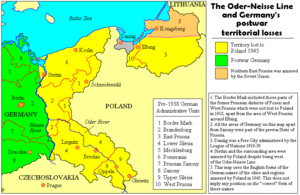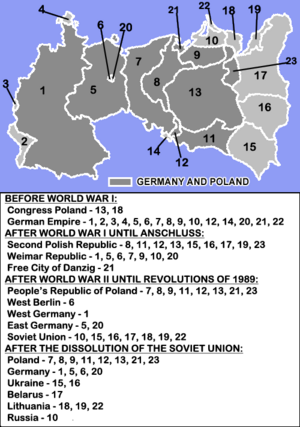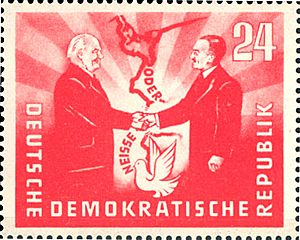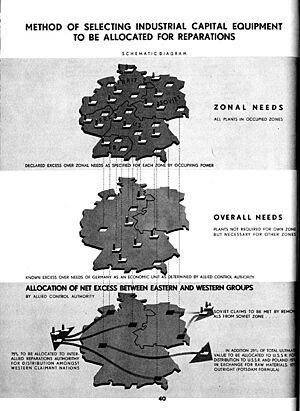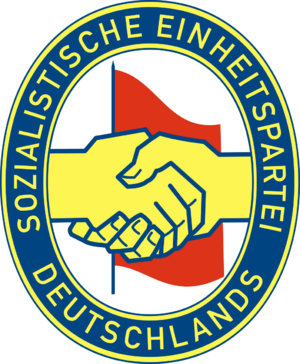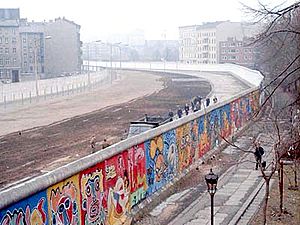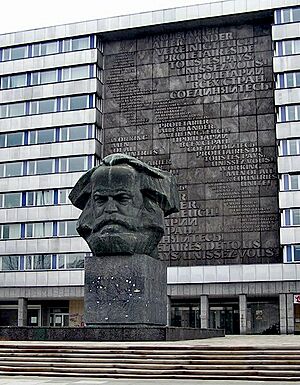History of East Germany facts for kids

The German Democratic Republic (GDR), also known as East Germany, existed from 1949 to 1990. It covered the area of what are now the German states of Mecklenburg-Vorpommern, Brandenburg, Berlin (but not West Berlin), Sachsen, Sachsen-Anhalt, and Thüringen. This area was controlled by the Soviet Union after World War II. The rest of Germany was controlled by British, American, and French armies.
After the western parts of Germany joined together to form West Germany in May 1949, East Germany was created on October 7, 1949. East Germany was a communist country and part of the Eastern Bloc of Soviet-allied nations. The Socialist Unity Party of Germany (SED) ruled the country. It had a command economy, where the government controlled everything. East and West Germany reunited on October 3, 1990. East Germany became part of West Germany's system of liberal democracy and a market economy.
Contents
How East Germany Was Created (1945–1949)
Germany Divided After World War II
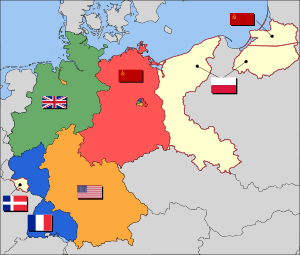
After World War II, the winning countries (the United States, United Kingdom, France, and the Soviet Union) decided how to divide Germany.
The Yalta and Potsdam Conferences
At the Yalta Conference in February 1945, the Allies agreed to divide Germany into occupation zones. They also decided to set up a committee to see if Germany should be split into several countries. After Germany surrendered, the Allies took control. Each country was responsible for its own zone.
The Potsdam Conference in July/August 1945 officially recognized these zones. The Soviet zone included the states of Brandenburg, Mecklenburg-Vorpommern, Saxony, Saxony-Anhalt, and Thuringia. The city of Berlin was also divided among the four powers. Some German land east of the Oder and Neisse rivers was given to Poland and the Soviet Union. Millions of Germans living in these areas had to move to Allied-controlled Germany. By the time East Germany was founded, many of its people were Germans who had moved from other Eastern European countries.
War Reparations
Each country took control of its zone by June 1945. They wanted to remove Nazi influence and rebuild Germany as a democracy. However, the western zones and the Soviet zone started to develop differently. The Soviets took a lot of industrial equipment from their zone as reparations (payments for war damages).
The Soviets took factories and equipment, which was about one-third of the eastern zone's production power. In the western zones, some German industries were also dismantled until 1951. The Soviets were supposed to send raw materials to the western zones in return, but they did not.
The Soviet authorities took over military industries and those owned by former Nazis. These made up about 60% of all industrial production in the Soviet zone. Most heavy industries were claimed by the Soviet Union. The remaining industries were taken over by the state, leaving only 40% of production to private businesses.
Land Reforms
The land reform program took land from owners with more than 100 hectares (about 247 acres) and from former Nazis. This land was then given to about 500,000 farmers and refugees. Some large farms became collective farms, called Landwirtschaftliche Produktionsgenossenschaft (LPGs). State-owned farms were also set up.
Growing Political Differences
Economic differences and growing political tensions between the US and the Soviet Union led to the Cold War. In 1947, the Soviets refused to join the US's Marshall Plan, which helped rebuild Europe. In March 1948, the US, Britain, and France decided to unite their zones and create a West German republic. The Soviet Union responded by preparing to create an East German state.
The division became clear with the currency reform on June 20, 1948, which only happened in the western zones. Three days later, the Soviet zone introduced its own currency. When the new currency was brought to West Berlin, the Soviet Union started the Berlin Blockade to try and control all of Berlin. The Western Allies supplied Berlin by airbridge for 11 months until the Soviets lifted the blockade in May 1949.
Political Changes
In June 1945, the Soviet zone allowed anti-fascist political parties to form. Elections for new state legislatures were set for October 1946. The KPD and the SPD in East Germany merged in April 1946 to form the Socialist Unity Party of Germany (SED). This happened under pressure from the Soviet authorities. In the October 1946 elections, the SED won about 50% of the vote in each state. However, in Berlin, where the SPD remained independent, the SPD won more votes than the SED.
In May 1949, elections were held for the German People's Congress to write a constitution for East Germany. Communists won these elections, giving them a majority in the Congress. On October 7, 1949, the German Democratic Republic (East Germany) was officially created. Wilhelm Pieck, a party leader, became the first president. The Soviet Union then handed over control to the new German state.
Early Years (1949–1955)
The SED as the Main Party
The SED controlled the National Front, a group of all political parties and organizations. The 1949 constitution said East Germany was a republic with two parts of parliament: the Länderkammer (States Chamber) and the Volkskammer (People's Chamber). The Volkskammer was the highest state body. The SED controlled the Council of Ministers and made the Volkskammer mostly approve what the SED wanted. People voted on a single list of candidates prepared by the National Front.
All SED members working in government followed party decisions. The State Security Service (Staatssicherheitsdienst, known as the Stasi) acted like Soviet spy agencies.
The Third SED Party Congress in July 1950 focused on making industry grow. The industrial sector, which employed 40% of workers, was largely taken over by the state. These state-owned businesses were called People's Enterprises (Volkseigener Betrieb—VEB). The First Five-Year Plan (1951–55) started centralized state planning. It set high production goals for heavy industry. The pressure of this plan caused many East Germans to leave for West Germany.
In July 1952, a new economic policy called "Planned Construction of Socialism" was adopted. It aimed to strengthen state-owned businesses and use socialist economic rules.
The churches, though promised religious freedom, faced pressure. Some church leaders opposed the SED. By 1953, about 37,000 people were leaving East Germany each month.
The Uprising of June 1953
After Joseph Stalin died in March 1953, the SED announced a "New Course" to improve workers' lives. This policy, based on a Soviet idea, focused on making more consumer goods available. The SED also tried to ease economic problems by reducing taxes and offering state loans to private businesses.
However, production quotas (the amount of work expected) remained high. When these quotas were raised in 1953, it led to the 1953 Uprising. Workers went on strike and protested in major industrial areas, demanding economic reforms. The Volkspolizei (police) and the Soviet Army stopped the uprising. About 100 people were killed.
Becoming More Independent
In 1954, the Soviet Union gave East Germany more independence. Reparations payments ended, and the Soviet-owned companies were returned to East Germany. The five original states of the Soviet zone were replaced by fifteen districts in 1952. East Germany also joined the Council for Mutual Economic Assistance (Comecon) in 1950.
In 1955, Prime Minister Otto Grotewohl signed a treaty with the Soviet Union. This treaty stated that East Germany was "free to decide questions of its internal and foreign policy." Soviet forces would stay in the country but would not interfere in its internal affairs. On May 14, 1955, East Germany joined the Warsaw Pact, a military alliance of communist countries. In 1956, the National People's Army (NVA) was created.
Economic Policy (1956–1975)
Collectivization and State Control of Farms and Factories (1956–1963)
In 1956, Soviet leader Nikita Khrushchev criticized Stalinism. Some leaders within the SED wanted reforms in East Germany. However, those who pushed for radical changes were quickly removed from the party and imprisoned.
The SED confirmed Walter Ulbricht's leadership and announced the Second Five-Year Plan (1956–1960). This plan focused on "modernization, mechanization, and automation" to improve technology. The government aimed to increase industrial production by 55% and focus on heavy industry.
The Second Five-Year Plan also pushed for more collective farms and state control of industries. By 1958, most farms were still privately owned. The SED then set production quotas for private farmers and encouraged them to join collective farms. By mid-1960, nearly 85% of all farmland was part of collective farms. By 1961, the socialist sector produced 90% of East Germany's farm products.
To speed up state control of industry, the SED offered private business owners a 50% partnership if they turned their companies into VEBs (state-owned enterprises). By the end of 1960, private businesses controlled only 9% of industrial production.
The Second Five-Year Plan faced problems, so it was replaced by the Seven-Year Plan (1959–65). This new plan aimed to match West Germany's production per person by the end of 1961. It set even higher production goals. Many people continued to leave East Germany, especially young, skilled workers. Between 1949 and 1961, over 2.5 million citizens left.
New Economic System (1963–1970)
Industrial growth slowed after 1959. The Soviet Union suggested that East Germany use ideas from Soviet economist Evsei Liberman, who believed in profitability and market principles. In 1963, Ulbricht adopted some of these ideas and introduced the New Economic System (NES). This program allowed for some local decision-making and considered market factors. The NES aimed to make East Germany a leading industrial nation.
Under the NES, central planning set overall production goals. However, groups of state-owned enterprises (VVBs) had more control over their own finances, technology, and workers. The NES said that production decisions should be based on how profitable they were. It also said that salaries should reflect performance, and prices should respond to supply and demand.
The NES brought new, educated leaders into politics and the economy. Ulbricht allowed younger, more skilled members to join the top ranks of the SED. This created a division between political and economic leaders. The focus on professional skills meant that managers were chosen for their training, not just their loyalty to the party. Real wages increased from 1964 to 1967, and more consumer goods, including luxury items, became available.
In 1968, Ulbricht launched the Economic System of Socialism (ESS), which replaced the NES. This system focused on high-tech industries to achieve self-sufficient growth. Centralized planning was brought back for important areas like electronics, chemicals, and plastics. Large industrial groups were formed to combine related industries. Price subsidies were used to help favored sectors grow. However, the ESS failed to meet its goals, and the reform effort ended in 1970.
The Main Task
The Main Task, introduced by Erich Honecker in 1971, set the domestic policy for the 1970s. This program emphasized Marxism–Leninism and the idea of class struggle. The SED launched a big campaign to make people support its Soviet-style socialism.
The Main Task still aimed for industrial progress but within a centrally planned economy. It also introduced "consumer socialism," which focused on providing more material goods for the working class. The government changed wage policies and worked to increase the availability of consumer goods.
The government also built new homes and renovated old ones. Most new housing went to working-class families. Rents were very low because they were subsidized. Since almost half of the workforce was women, child-care facilities like nurseries and kindergartens were provided. Women also received paid maternity leave. Retirement benefits were increased.
Foreign Policy (1967–1975)
Ulbricht and Détente
From 1967 to 1971, Ulbricht's foreign policy reacted to the start of détente (a period of less tension) with the West. Détente offered East Germany a chance to gain international recognition. However, Ulbricht was slow to improve relations with West Germany. Both German states still wanted to reunite, but they had very different political systems. In 1968, the SED changed the constitution to make East Germany a fully communist state. It said that power came from the working class, led by the SED.
Ulbricht worried that hopes for a democratic government or reunification with West Germany would cause unrest. East Germans were still attracted to West Germany's democratic politics and higher living standards.
In the late 1960s, Ulbricht made the Council of State the main government body. This council, led by Ulbricht and controlled by the SED, brought in a new period of political conservatism. Ulbricht's foreign policy focused on strengthening ties with Warsaw Pact countries and opposing détente. In 1967, he convinced Czechoslovakia, Poland, Hungary, and Bulgaria to sign mutual assistance treaties with East Germany. The Ulbricht Doctrine said these countries would not normalize relations with West Germany unless West Germany formally recognized East German independence.
Ulbricht also encouraged Soviet bloc countries to reduce ties with the industrialized West. In 1968, he pushed Comecon states to develop their economies "by their own means." The SED saw calls for freedom and democracy within the Soviet bloc as a danger. So, it criticized Prague's new political course, which led to the Soviet military and other Warsaw Pact forces intervening in Czechoslovakia in 1968.
In August 1970, the Soviet Union and West Germany signed the Moscow Treaty. They promised not to use force and confirmed the Oder-Neisse line as the border. Moscow then pressured East Germany to talk with West Germany. Ulbricht resisted, which weakened his leadership. In May 1971, the SED Central Committee chose Erich Honecker to replace Ulbricht as the party's first secretary.
Honecker and East-West Relations
Honecker was loyal to the Soviet Union but also flexible about détente. At the Eighth Party Congress in June 1971, he presented the new government's political plan. Honecker said East Germany no longer aimed for a unified Germany. Instead, it adopted a policy of Abgrenzung (demarcation or separation). This meant East Germany defined itself as a separate "socialist state" and emphasized its loyalty to the Soviet Union. Abgrenzung helped with détente negotiations, leading to the Four Power Agreement on Berlin in 1971 and the Basic Treaty with West Germany in December 1972.
The Berlin Agreement and the Basic Treaty made relations between East and West Germany normal. The Berlin Agreement (effective June 1972) protected trade and travel between West Berlin and West Germany. It also aimed to improve communication between East and West Berlin. The Basic Treaty (effective June 1973) officially recognized two German states. Both countries promised to respect each other's independence. They would exchange diplomatic missions and establish commercial, tourist, cultural, and communication ties. In September 1973, both countries joined the United Nations. This gave East Germany the international recognition it had wanted.
Two German States
From the mid-1970s, East Germany was positioned between East and West. A 1974 change to the Constitution removed all mentions of the "German nation" and "German unity." It called East Germany "a socialist nation-state of workers and peasants" and "an inseparable part of the socialist community of states." However, the SED leaders struggled to make East Germans feel a strong connection to the Soviet Union. Honecker eventually used the phrase "citizenship, GDR; nationality, German." This showed that East Germans still felt a strong connection to German traditions and culture, and to West Germany.
Even though Abgrenzung was Honecker's main policy, détente strengthened ties between the two German states. Between 5 and 7 million West Germans and West Berliners visited East Germany each year. Telephone and mail services improved greatly. East Germans had more direct contact with West German politics and wealth, especially through radio and television. West Germany supplied East Germany with high-quality consumer goods. East Germans could buy these goods in special shops using Western currency or in other shops using East German currency.
As part of the general détente, East Germany signed the Helsinki Final Act in July 1975. This agreement was supposed to guarantee human rights. After it was signed, about 120,000 East Germans applied to leave the country, but their requests were denied.
Domestic Policy (1970s)
East German Identity
From the start, East Germany tried to create its own identity. The SED rejected any connection between East Germany and Prussia, a former German kingdom. They destroyed old Prussian buildings and removed statues. Instead, the SED focused on the "progressive" parts of German history, like peasant revolts and the struggles of the working class. However, by 1956, some Prussian traditions, like in the army, started to reappear.
After 1976, East Germany began to see its own history as the most important part of German history. It claimed historical figures like Karl Freiherr vom Stein and Martin Luther. The statue of Frederick the Great was even put back in East Berlin. This showed that East Germany was changing its official view of Prussia.
Dealing with Dissidents
Despite détente, the Honecker government remained committed to Soviet-style socialism. It continued to be strict with people who disagreed with the government (dissidents). However, some Marxist thinkers within the SED again called for democratic reforms. One such person was the poet-singer Wolf Biermann. He was expelled from East Germany in November 1976 for his activities. After this, the SED punished over 100 other intellectuals who spoke out.
East German writers began publishing their political views in West German newspapers. One famous example was Rudolf Bahro's book Die Alternative, published in West Germany in August 1977. This led to his arrest, imprisonment, and deportation to West Germany.
Even after many artists left in protest, the SED continued its strict policy against dissidents. Literature, which was one of the few ways to express opposition, faced censorship. This led to more prominent writers leaving the country until 1981. The Lutheran Church also became openly critical of SED policies. Although the SED increased censorship of church publications in 1980-81, it generally remained flexible toward the church. For example, a new church building was allowed in Eisenhüttenstadt in May 1981, even though the city was considered a "socialist city" where churches were not usually permitted.
10th Party Congress (1981)
The 10th Party Congress in April 1981 focused on improving the economy, strengthening the socialist system, and improving foreign relations, especially with West Germany. General Secretary Honecker emphasized the importance of educating loyal party members. He said that many party members and secretaries had completed higher education or party training.
Honecker stressed strict central control within the party. The congress confirmed East Germany's economic and social policies and its strong commitment to the Soviet Union in foreign policy. The SED approved the Soviet intervention in Afghanistan, unlike some other communist parties.
The SED's Central Committee, which used to give advice, became a body that mostly approved decisions during this congress. The Politburo and Secretariat remained largely unchanged. The congress also set very high goals for the new Five-Year Plan (1981–85), aiming for higher productivity and better quality products, even though the previous plan had not been met.
Decline and Fall of East Germany (1975–1989)
The Coffee Crisis (1976–1979)
Germans traditionally drink a lot of coffee, so coffee imports were very important. A huge rise in coffee prices from 1976 to 1977 quadrupled the cost of importing coffee for East Germany. This caused big financial problems because East Germany always lacked hard currency (money that could be easily exchanged internationally).
As a result, in mid-1977, the government removed most cheaper coffee brands from stores. They also limited coffee use in restaurants and public offices. They introduced a new type of coffee called Mischkaffee (mixed coffee), which was only 51% coffee and 49% fillers like chicory and rye.
People hated the taste of this new coffee, and the whole event became known as the "coffee crisis." The crisis ended after 1978 when world coffee prices dropped and East Germany made a deal with Vietnam for more coffee. This event clearly showed East Germany's ongoing economic problems.
Growing International Debt
East Germany's international debts grew throughout the 1980s, reaching over 40 billion Deutschmarks owed to Western banks. While this amount might not seem huge, it was very large compared to East Germany's ability to export enough goods to earn the hard currency needed to pay these debts. A report in October 1989 for the Politburo (the Schürer-Papier) showed that East Germany needed to greatly increase its exports to stabilize its debt.
Much of the debt came from East Germany trying to export more goods, which required importing parts and technology. They also imported consumer goods to maintain living standards. East Germany was competitive in some areas like mechanical engineering. However, their attempt to compete in microchips failed and used up a lot of resources and hard currency. Another problem was losing a source of hard currency from re-exporting Soviet oil, which until 1981 was sold below world market prices. This loss led to a noticeable dip in living standards.
The Regime Collapses (1989)
In May 1989, local elections were held. People were angry when the National Front candidates supposedly won 98.5% of the vote. This meant the election was clearly rigged, even though many people risked punishment by rejecting the single candidate. More and more citizens applied to leave the country or left illegally. In August 1989, Hungary's government removed its border restrictions with Austria. This was the first break in the "Iron Curtain." In September 1989, over 13,000 East Germans escaped to the West through Hungary. Thousands more tried to reach the West by staying at West German embassies in other East European capitals. East Germany then announced special trains to take these refugees to West Germany, calling them "irresponsible traitors." Meanwhile, large protests in Dresden and Leipzig demanded democratic reforms.
Ignoring the country's problems, Honecker and the Politburo celebrated East Germany's 40th anniversary on October 7. During the parade, members of the FDJ chanted, "Gorby, help us! Gorby, save us!" referring to Soviet leader Mikhail Gorbachev. That same night, the first large protest happened in East Berlin. Similar protests for freedom of speech and press spread across the country, putting pressure on the government to change. One of the biggest protests was in Leipzig. Troops were sent but pulled back by local party officials. To prevent a popular uprising, the Politburo removed Honecker on October 18.
Honecker's replacement was Egon Krenz, who was almost as disliked. He promised to open up the government, but few East Germans believed him. Protests continued, and people kept fleeing to West Germany. Some schools even closed because there weren't enough students or teachers.
On November 9, to stop the protests and mass exodus, the government announced new travel rules. East Germans could now travel directly to West Germany. However, the government's spokesman, Günter Schabowski, was not told that the rules would take effect the next day. When a reporter asked when they would start, Schabowski replied, "As far as I know ... immediately, without delay." When this was shown on West German television, large crowds gathered at the Berlin Wall checkpoints. The guards, unprepared and outnumbered, finally let them through. This led to the fall of the Berlin Wall.
The fall of the Berlin Wall effectively ended the SED's rule. Communist rule formally ended on December 1, when the Volkskammer removed the parts of the Constitution that said East Germany was a socialist state led by the SED. Krenz and the Politburo resigned two days later. Hans Modrow, who had just become prime minister, became the leader of a country in collapse.
Financial Situation in 1990
Most people didn't know about East Germany's severe economic problems until late 1989. At this time, the government asked West Germany for new loans. However, opening the borders meant West Germany no longer wanted to support East Germany, as they began working towards reunification. The new East German government faced huge financial problems. Massive financial support from West Germany (about half of East Germany's budget in 1990) after the March 1990 elections prevented a financial collapse before reunification.
Reunification
Although some tried to create a non-socialist East Germany, calls for reunification with West Germany quickly took over. There were two main legal ways to do this. West Germany's Basic Law (its constitution) had a way for new states to join the Federal Republic by a simple vote (Article 23). This was used in 1957 for the state of Saarland. Another way (Article 146) was to write a completely new constitution for a united Germany.
It became clear that using Article 23 would be much faster. East Germany was in a very weak economic and political state. So, it was decided to use the quicker Article 23 process. This meant reunification could happen in just six months. However, it also meant that East Germany's new democracy ended quickly, and West Germany's laws and institutions were adopted. This prevented debates about East Germany's social institutions, like its childcare, education, and healthcare systems.
East Germany held its first free elections in March 1990. The SED reorganized as the Party of Democratic Socialism (PDS) and tried to improve its image. But the PDS was heavily defeated by the Alliance for Germany, a group led by the East German branch of the CDU, which wanted quick reunification. A "grand coalition" government was formed, and Lothar de Maizière became Prime Minister on April 12.
After talks between the two German states, a treaty on Monetary, Economic, and Social Union was signed on May 18 and took effect on July 1. This replaced the East German mark with the Deutsche Mark (DM). The treaty also set the stage for East Germany to join West Germany under Article 23.
In mid-July, most state property in East Germany was transferred to the Treuhand, which was in charge of turning state-owned businesses into private, market-oriented companies. On July 22, a law was passed to bring back the five original federal states of East Germany. On August 31, the Unification Treaty set October 3 as the date for East Germany to join West Germany. The Unification Treaty said that East Germany's laws would be replaced by West Germany's laws on that date. The Volkskammer approved the treaty on September 20, effectively voting East Germany out of existence.
In September, after talks with the United States, the Soviet Union, France, and the United Kingdom, the conditions for German reunification were agreed upon. The Allies gave up their old rights in Germany and agreed to remove all occupying troops by 1994. It was also agreed that a reunited Germany could choose its alliances. On October 3, 1990, East Germany officially ceased to exist. The five recreated states joined West Germany, and East and West Berlin reunited to form a single city-state.
See also
 In Spanish: Historia de Alemania Oriental para niños
In Spanish: Historia de Alemania Oriental para niños
- History of Germany
- Leaders of East Germany


